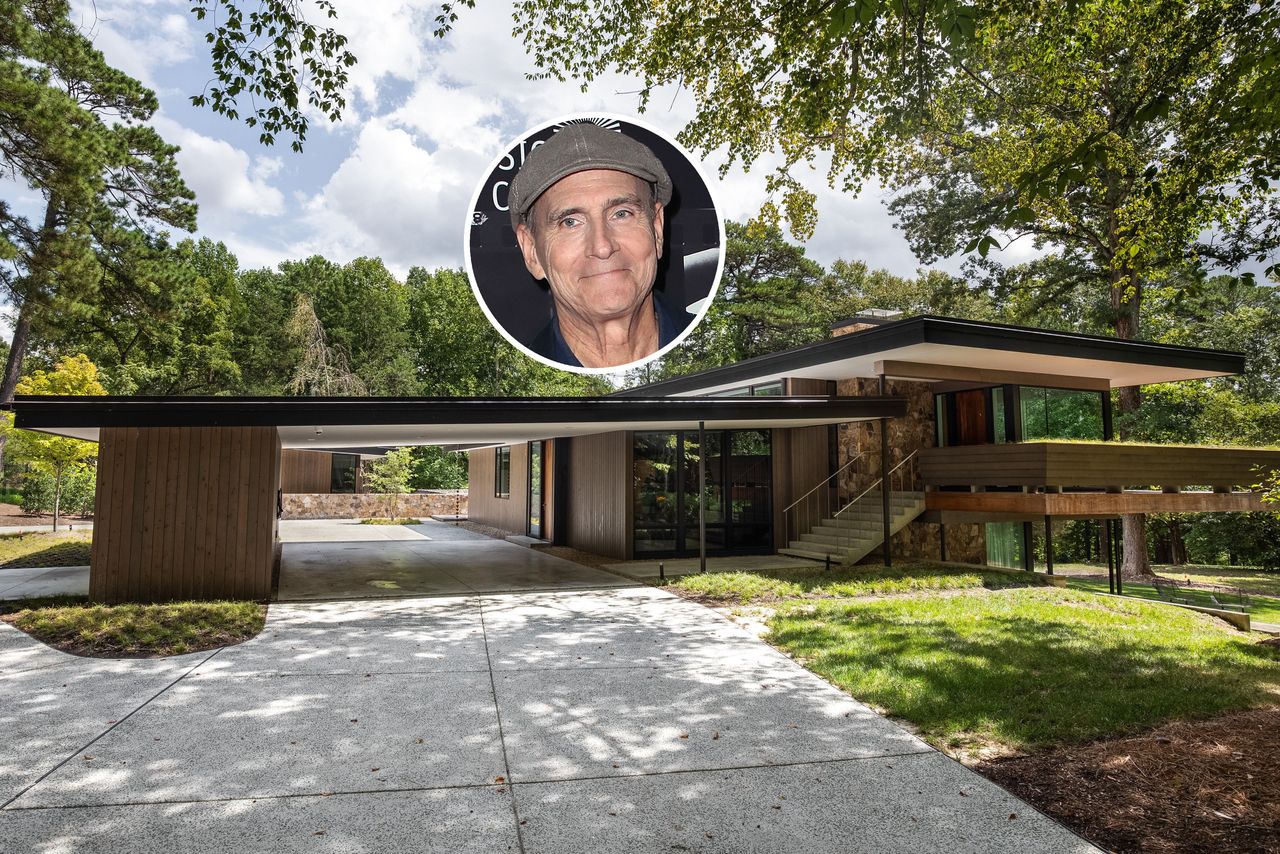James Taylor’s Childhood Home Was a Ghost of Itself, Until a New York Couple Saved It
The North Carolina property was in bad shape when its current owners bought it for $1.66 million, but a $2 million renovation brought the Midcentury Modern back to life
In the song “Copperline,” James Taylor sings about the Morgan Creek neighborhood where he grew up in Chapel Hill, N.C., lamenting the overdevelopment that has since changed the area. “I tried to go back, as if I could, all spec houses and plywood, tore up and tore up good,” the song goes.
The lyrics refer to “the McMansions speculators tend to drop everywhere,” Mr. Taylor explained in an email.
But thanks to its current owners, James Keith Brown, 60, a senior adviser at global-investment firm Coatue Management, and Eric G. Diefenbach, 63, an attorney, Mr. Taylor’s own childhood home still stands—and its lot of nearly 25 acres hasn’t become the site of a subdivision.
The couple, who are art collectors and museum supporters, bought the rundown, seven-bedroom, 3,172-square-foot, 1950s wood-and-glass Midcentury Modern home at an auction in July 2016 for $1.66 million. They then spent about $2 million on a restoration and renovation, finishing in the spring of 2021.
“We thought it was important to preserve the legacy of the Taylors,” says Mr. Brown. “Besides, it’s a beautiful house.”
The home was the vision of Mr. Taylor’s mother, Gertrude “Trudy” Taylor. She took the lead in its design, Mr. Taylor says, and was influenced by Frank Lloyd Wright.
“Designing, building, decorating and landscaping that house was her creative outlet,” he says of his mother. “The house was a declaration of her uniqueness and, by association, our otherness. I remember being proud of it.”
The fundamental aim of the renovation is to honor the original design, says Matthew Griffith, a founding principal of a Raleigh-based architecture practice called in situ studio. Mr. Griffith says his firm focused on making the house “how it was supposed to be,” by uniting the work of its original architects: the celebrated Midcentury Modernist George Matsumoto, then the dean of the School of Design at North Carolina State University, and renowned Durham architect John Latimer.
Mr. Griffith says they didn’t change the footprint of the main two-story structure, focusing instead on creating a cohesion between the front and back by redoing the siding and windows, and adding skylights. They reworked the floor plan to make it a three-bedroom, three-bathroom house by breaking up some rooms and expanding others.
Outside, a partial deck was made to wrap around the whole house. An existing guesthouse, which was prefabricated, was replaced with a 786-square-foot, two-bedroom, one-bathroom custom-built version with a family room and a kitchen that mimics the one in the main house. A swimming pool and a pool house was added to one side of the yard.
Mr. Brown and Mr. Diefenbach live in a prewar co-op on West 72 Street in Manhattan, which they created out of three apartments and filled with art, including works by Franz Ackermann and Olafur Eliasson. The couple also owns an 8,000-square-foot, four-bedroom, five-bathroom, art-filled modern house on 11 acres in Ridgefield, Conn., where Mr. Diefenbach is on the board of the Aldrich Contemporary Art Museum.
Mr. Diefenbach says updating and reusing beautiful vintage architecture was one appeal of restoring the Taylor home. “We had been looking for another platform for art and the house was ideal,” he says.
Another impetus for buying the house was to be close to family, says Mr. Brown, who grew up in Siler City, where his mother still lives. He graduated from UNC-Chapel Hill in 1984, where he has served on numerous boards and committees. They have 36 nieces and nephews, 16 of whom live near the Morgan Creek house. Mr. Brown says he has happy memories of North Carolina and missed being close to his relatives.
Mr. Taylor’s memories of growing up in North Carolina are more ambiguous. His family moved from Boston to Chapel Hill in 1951 when his father, Isaac “Ike” Taylor, a Harvard-trained physician, accepted a position with the University of North Carolina School of Medicine.
But just when the house was finished, around 1955, his father volunteered to be a medical officer for the Navy in Antarctica. During his two years there, Trudy Taylor became increasingly alienated from the politics and culture of North Carolina, which became a “major dynamic in all of our lives,” Mr. Taylor says.
“She refused to put down roots and constantly impressed upon us the idea that civilized life was elsewhere (to the north),” he says. “Her constant, epic work of tending and shaping the landscape around the house was not only her labor of love but a fierce proclamation of her unique independence. We got it.”
Ike Taylor returned to North Carolina from Antarctica an alcoholic, straining his marriage and his relationship with his children, Mr. Taylor recounts in his audio memoir, “Break Shot: My First 21 Years.” His parents divorced and sold the house in 1974.
When the home went up for a sealed-bid auction in June 2016, it was in bad shape, with termite damage and a dilapidated roof, says Sarah Sonke, owner of ModHomes Realty and AuctionFirst. She says the house had been vacant for some time but wasn’t officially on the market; developers were aware of it and had made lowball offers with the intent to take down the home to build multifamily units. Ms. Sonke says she was hired by the seller, whose parents had been living there before they died, to find a buyer who would keep the house and property intact.
George Smart, the executive director of NCModernist, a nonprofit that documents preserves, and promotes modern architecture in North Carolina, organized a tour of the house before the auction that attracted some 1,300 people, including many who wanted to play guitar on the deck. Ms. Sonke said locals stopped by with stories and memories about the Taylor family.
Musician and artist Kate Taylor, Mr. Taylor’s sister, says she is grateful for the restoration. The home was instrumental in her development and that of her siblings, including James, Livingston, Hugh and Alex, who died in 1993, says Ms. Taylor.
Trudy Taylor let the kids “run and roam” on the property, encouraging them to play music and make art: “It was an ideal breeding ground for creativity,” she says. “Looking back on it now, I can see that it was extraordinary.”
 Copyright 2020, Dow Jones & Company, Inc. All Rights Reserved Worldwide. LEARN MORE
Copyright 2020, Dow Jones & Company, Inc. All Rights Reserved Worldwide. LEARN MORE
This stylish family home combines a classic palette and finishes with a flexible floorplan
Just 55 minutes from Sydney, make this your creative getaway located in the majestic Hawkesbury region.
As Paris makes its final preparations for the Olympic games, its residents are busy with their own—packing their suitcases, confirming their reservations, and getting out of town.
Worried about the hordes of crowds and overall chaos the Olympics could bring, Parisians are fleeing the city in droves and inundating resort cities around the country. Hotels and holiday rentals in some of France’s most popular vacation destinations—from the French Riviera in the south to the beaches of Normandy in the north—say they are expecting massive crowds this year in advance of the Olympics. The games will run from July 26-Aug. 1.
“It’s already a major holiday season for us, and beyond that, we have the Olympics,” says Stéphane Personeni, general manager of the Lily of the Valley hotel in Saint Tropez. “People began booking early this year.”
Personeni’s hotel typically has no issues filling its rooms each summer—by May of each year, the luxury hotel typically finds itself completely booked out for the months of July and August. But this year, the 53-room hotel began filling up for summer reservations in February.
“We told our regular guests that everything—hotels, apartments, villas—are going to be hard to find this summer,” Personeni says. His neighbours around Saint Tropez say they’re similarly booked up.
As of March, the online marketplace Gens de Confiance (“Trusted People”), saw a 50% increase in reservations from Parisians seeking vacation rentals outside the capital during the Olympics.
Already, August is a popular vacation time for the French. With a minimum of five weeks of vacation mandated by law, many decide to take the entire month off, renting out villas in beachside destinations for longer periods.
But beyond the typical August travel, the Olympics are having a real impact, says Bertille Marchal, a spokesperson for Gens de Confiance.
“We’ve seen nearly three times more reservations for the dates of the Olympics than the following two weeks,” Marchal says. “The increase is definitely linked to the Olympic Games.”

Getty Images
According to the site, the most sought-out vacation destinations are Morbihan and Loire-Atlantique, a seaside region in the northwest; le Var, a coastal area within the southeast of France along the Côte d’Azur; and the island of Corsica in the Mediterranean.
Meanwhile, the Olympics haven’t necessarily been a boon to foreign tourism in the country. Many tourists who might have otherwise come to France are avoiding it this year in favour of other European capitals. In Paris, demand for stays at high-end hotels has collapsed, with bookings down 50% in July compared to last year, according to UMIH Prestige, which represents hotels charging at least €800 ($865) a night for rooms.
Earlier this year, high-end restaurants and concierges said the Olympics might even be an opportunity to score a hard-get-seat at the city’s fine dining.
In the Occitanie region in southwest France, the overall number of reservations this summer hasn’t changed much from last year, says Vincent Gare, president of the regional tourism committee there.
“But looking further at the numbers, we do see an increase in the clientele coming from the Paris region,” Gare told Le Figaro, noting that the increase in reservations has fallen directly on the dates of the Olympic games.
Michel Barré, a retiree living in Paris’s Le Marais neighbourhood, is one of those opting for the beach rather than the opening ceremony. In January, he booked a stay in Normandy for two weeks.
“Even though it’s a major European capital, Paris is still a small city—it’s a massive effort to host all of these events,” Barré says. “The Olympics are going to be a mess.”
More than anything, he just wants some calm after an event-filled summer in Paris, which just before the Olympics experienced the drama of a snap election called by Macron.
“It’s been a hectic summer here,” he says.

AFP via Getty Images
Parisians—Barré included—feel that the city, by over-catering to its tourists, is driving out many residents.
Parts of the Seine—usually one of the most popular summertime hangout spots —have been closed off for weeks as the city installs bleachers and Olympics signage. In certain neighbourhoods, residents will need to scan a QR code with police to access their own apartments. And from the Olympics to Sept. 8, Paris is nearly doubling the price of transit tickets from €2.15 to €4 per ride.
The city’s clear willingness to capitalise on its tourists has motivated some residents to do the same. In March, the number of active Airbnb listings in Paris reached an all-time high as hosts rushed to list their apartments. Listings grew 40% from the same time last year, according to the company.
With their regular clients taking off, Parisian restaurants and merchants are complaining that business is down.
“Are there any Parisians left in Paris?” Alaine Fontaine, president of the restaurant industry association, told the radio station Franceinfo on Sunday. “For the last three weeks, there haven’t been any here.”
Still, for all the talk of those leaving, there are plenty who have decided to stick around.
Jay Swanson, an American expat and YouTuber, can’t imagine leaving during the Olympics—he secured his tickets to see ping pong and volleyball last year. He’s also less concerned about the crowds and road closures than others, having just put together a series of videos explaining how to navigate Paris during the games.
“It’s been 100 years since the Games came to Paris; when else will we get a chance to host the world like this?” Swanson says. “So many Parisians are leaving and tourism is down, so not only will it be quiet but the only people left will be here for a party.”
This stylish family home combines a classic palette and finishes with a flexible floorplan
Just 55 minutes from Sydney, make this your creative getaway located in the majestic Hawkesbury region.























